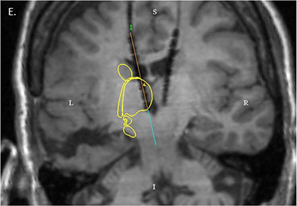These days, it sounds a bit old-fashioned to ask the question: “Where is consciousness located in the brain?†The prevailing thinking is that consciousness lives in the network, rather than in one particular place. Still, neuroscientists sometimes get an intriguing glimpse of a critical link in the network.
A recent paper in the journal Epilepsy & Behavior describes an epilepsy patient who had electrodes implanted within her brain at Emory University Hospital, because neurologists wanted to understand where her seizures were coming from and plan possible surgery. Medication had not controlled her seizures and previous surgery elsewhere had not either.

MRI showing electrode placement. Yellow outline indicates the location of the caudate and thalamus. Image from Leeman-Markowsi et al, Epilepsy & Behavior (2015).
During intracranial EEG monitoring, implanted electrodes detected a pattern of signals coming from one part of the thalamus, a central region of the brain. The pattern was present when the patient was conscious, and then stopped as soon as seizure activity made her lose awareness.
The pattern of signals had a characteristic frequency – around 35 times per second – so it helps to think of the signal as an auditory tone. Lead author Beth Leeman-Markowski, director of EUH’s Epilepsy Monitoring Unit at the time when the patient was evaluated, describes the signal as a “buzz.â€
“That buzz has something to do with maintenance of consciousness,†she says. Read more




